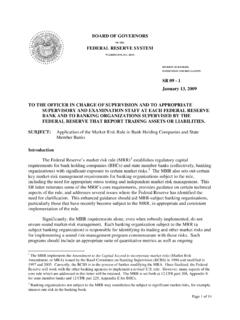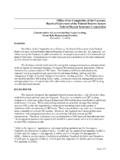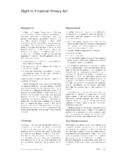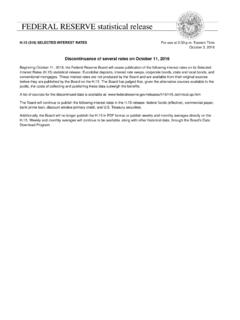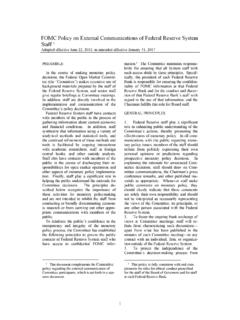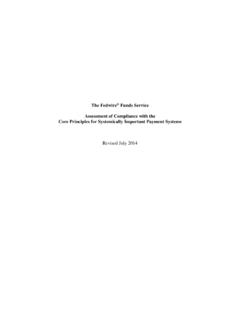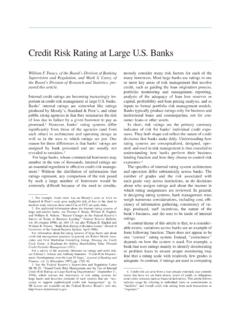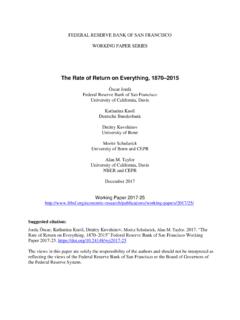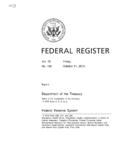Transcription of Regulation D Reserve Requirements - Federal …
1 Regulation D1. Reserve Requirements Background tronic device, including by debit card ..''5 The following types of accounts are transaction Regulation D imposes Reserve Requirements on accounts'' under Regulation D: certain deposits and other liabilities of depository Demand deposit accounts institutions2 solely for the purpose of implementing monetary policy. It specifies how depository insti- NOW accounts tutions must classify different types of deposit Savings deposit accounts are specifically ex- accounts for Reserve Requirements purposes. cluded from the definition of transaction account, even though they permit third-party transfers, Types of Deposits Covered provided that the depository institution complies with the transfer and withdrawal limitations appli- Regulation D imposes Reserve Requirements on cable to savings deposits'' under Regulation transaction accounts,'' nonpersonal time depos- Transaction accounts have the following charac- its,'' and Eurocurrency liabilities.
2 ''3 However, non- teristics: personal time deposits'' and Eurocurrency liabili- ties'' have been subject to a zero percent Reserve limited to demand, NOW, and ATS accounts requirement since the early 1990s. Accordingly, permit a depositor or account holder to make transaction accounts'' are the only category of unlimited transfers or payments to third parties deposit that is currently subject to a positive Reserve requirement under Regulation D. Deposi- permit a depositor to make unlimited transfers tory institutions are still required to classify their between accounts of the same depositor at the liabilities according to the Regulation D definitions same institution of transaction accounts,'' savings deposits,''.
3 Time deposits,'' or Eurocurrency liabilities'' in Demand Deposit Accounts connection with filing mandatory FR 2900 deposit Demand deposit accounts are payable on demand, or a deposit issued with an original maturity or required notice period of less than seven days, or a Transaction Accounts deposit representing funds for which the deposi- A transaction account is an account from which the tory institution does not Reserve the right to require depositor or account holder is permitted to make at least seven days' written notice of an intended transfers or withdrawals by negotiable or transfer- withdrawal. There are no eligibility restrictions on able instrument, payment order of withdrawal, this type of account.
4 Telephone transfer, or other similar device for the Demand deposits may also include deposits that purpose of making payments or transfers to third were incorrectly classified as another type of persons or others or from which the depositor may deposit for example, savings deposits for which make third-party payments at an automated teller the transfer or withdrawal limitations have been machine or a remote service unit, or other elec- exceeded and matured time deposits. Demand deposit accounts have the following 1. This section previously described the Requirements of characteristics: Regulation Q, which prohibited the payment of interest by member banks on demand deposits.
5 However, Section 627 of the no maturity period (or an original maturity of less Dodd-Frank Act repealed Section 19(i) of the Federal Reserve Act than seven days). (12 USC 371 a), the statutory prohibition against payment of interest on demand deposits, effective July 21, 2011. Accordingly, payable on demand (or on less than seven days'. Regulation Q was repealed effective as of that date. See 76 Fed. Reg. 42015 (July 18, 2011). notice). 2. All depository institutions, including commercial banks, savings banks, savings and loan associations, credit unions, and may be interest-bearing agencies and branches of foreign banks located in the United States, are subject to Reserve Requirements .
6 Institutions must satisfy Reserve Requirements by holding cash in their vaults or, if 5. 12 CFR (e) (definition of transaction account''). vault cash is insufficient, as a balance in account at a Federal 6. Regulation D requires that an account, to be classified as Reserve Bank (either an account of the institution or an account of a savings deposit,'' must not permit more than six convenient the institution's pass-through correspondent under section transfers or withdrawals per month from the account. Transfers (d)). and withdrawals that are considered convenient'' for this purpose 3. 12 CFR (f) ( Reserve requirement ratios for transaction are those made by preauthorized, automatic, telephonic agree- accounts, nonpersonal time deposits, and Eurocurrency liabili- ment, order or instruction, or by check, debit card, or similar order ties).
7 Made by the depositor and payable to third parties. 12 CFR. 4. See generally 12 CFR (definitions). (d)(2). Consumer Compliance Handbook Reg. D 1 (11/11). Reserve Requirements no limit on the number of withdrawals or transfers Nontransaction Accounts an account holder may make Time Deposits no eligibility Requirements Time deposits are accounts that have a maturity of at least seven days from the date of deposit. They NOW Accounts may be payable on a specified date not less than NOW (negotiable order of withdrawal) accounts seven days after the date of deposit, or after the allow an unlimited number of third-party payment expiration of a specified period of time not less than and other transactions and are classified as seven days after the date of deposit (for example, transaction accounts under Regulation D.)
8 Like thirty days after the date of deposit). Time deposits savings deposits,'' the depository institution must may also be payable upon receipt of written notice Reserve the right at any time to require seven days' from the depositor (required in the contract) not written notice of an intended withdrawal in order to less than seven days prior to withdrawal. If funds classify the account as a NOW account'' under are withdrawn from a time deposit account within Regulation D (in practice, this right is rarely, if ever, six days of the date of deposit or within six days of exercised). Unlike savings deposits,'' however, the most recent partial withdrawal, the specified NOW accounts are available only to individuals; early withdrawal penalty must be imposed (see governmental units; and corporations, partner- ''Early Withdrawal Penalties'' below).
9 There are no ships, associations, and organizations that are restrictions on who may hold a time deposit. operated primarily for religious, philanthropic, chari- Time deposits may be negotiable or non- table, educational, fraternal, or other similar pur- negotiable, transferable or nontransferable. They poses and not for profit. may be represented by a certificate, instrument, A depositor may access funds in a NOW account pass-book, statement, book-entry notation, or oth- in the same manner as a depositor may access erwise. If the deposit is automatically renewable, funds in a demand deposit account. For example, that fact should be indicated on the certificate or NOW account holders may use negotiable instru- other representation, along with the terms of ments (checks), drafts, telephonic or electronic renewal.
10 Orders or instructions, or other similar devices to Time deposit accounts have the following char- make payments or transfers to third persons or to acteristics: others. A NOW account holder may make an unlimited number of transfers to another of his or must have a maturity of at least seven days from her accounts at the same institution. the date of deposit NOW accounts have the following characteris- may require at least seven days' prior written tics: notice of intent to withdraw funds have no maturity date must be subject to early withdrawal penalties if funds are withdrawn within six days of the date of institution must Reserve the right at any time to deposit or within six days of the date of the require at least seven days' prior written notice of immediately preceding partial withdrawal an intended withdrawal may be interest-bearing permit unlimited transactions (transfers and with- drawals)

